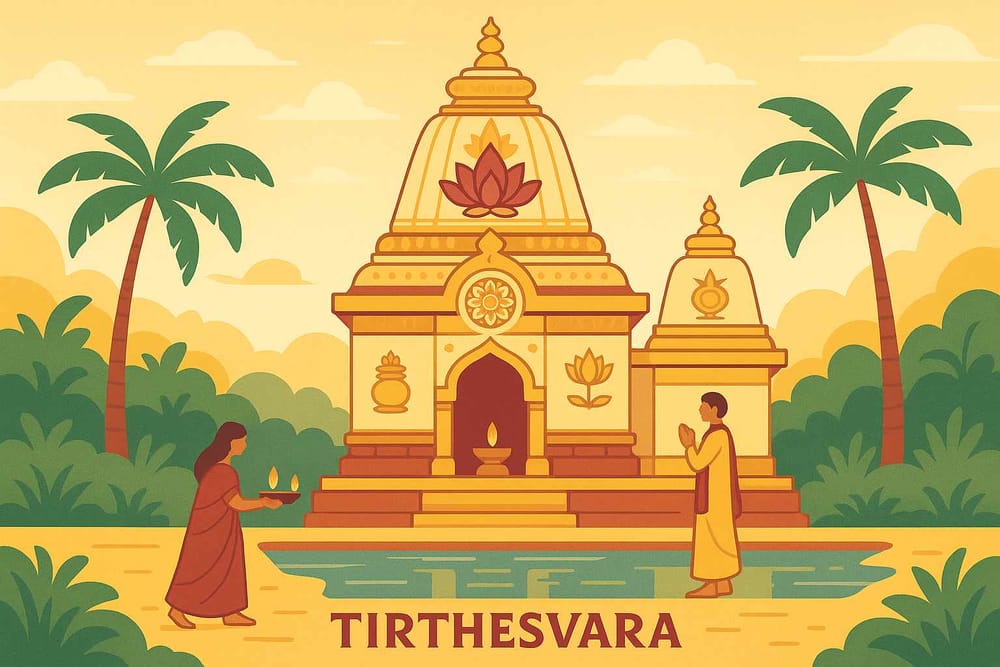
The Mystique of Tirthesvara-Sacred Siva Temple Explained
In the bustling, history-laden lanes of Bhubaneswar's Old Town, there are places where time seems to slow down. As you walk the path from the sacred Bindusagar to the magnificent Lingaraja temple, you might just stumble upon a serene abode of divinity—the Tirthesvara Siva Temple. It isn't a grand, towering structure that demands attention, but rather a quiet, intimate space that invites you in, promising a moment of peace and a deep connection with the divine.
The name itself, 'Tirthesvara', translates to the “Lord of sacred waters.” It feels so apt, as visiting this temple is like taking a dip in a holy river—it cleanses the soul and calms the mind. This isn't just a monument; it's a living, breathing space where faith echoes in every corner, and history is carved into every stone.
A Glimpse into the Past: The Temple's Enduring Legacy
Trying to pinpoint the exact date of Tirthesvara's birth is like trying to catch a whisper from the past. Some historians believe its beautiful form took shape during the 14th century, under the patronage of the Eastern Ganga dynasty, a golden era for art and spirituality in Odisha. Others feel its soul is even older, tracing its roots back to the Somavamsi rulers of the 10th-11th century. What we know for sure is that this temple has stood as a silent witness to centuries of unwavering devotion.
It was once a vibrant hub of culture and learning, a place where sages, scholars, and pilgrims from far and wide would gather. Imagine the philosophical discussions, the chanting of mantras, and the sharing of wisdom that must have filled its halls. It was a true centre of spiritual energy, a cornerstone of India's sacred geography.
The Poetry of Kalinga Architecture
The temple is a perfect example of the renowned Kalinga architectural style, where temples were not just buildings but conceived as earthly homes for the gods. The structure is simple yet profound, consisting of two main parts:
- The Vimana (Main Shrine): This is the heart of the temple, a *rekha deul* style structure with a beautiful, pyramid-like tower or *shikhara* that gracefully reaches for the heavens. It houses the primary deity and is the focal point of all worship.
- The Jagamohana (Assembly Hall): This is the *pidha deul* or hall where devotees gather to pray, meditate, and feel the divine presence. It’s a space designed for community and shared devotion, connecting the worshippers with the sanctum.
As you look closer, the walls come alive with intricate carvings of gods, goddesses, and celestial beings. The doorjambs are guarded by carved *dvarapalas* (door guardians), and the lintel above features a beautiful depiction of Gaja Laxmi. Step inside the sanctum, and you'll find the Shiva Lingam resting within a circular *Yonipitha*. It’s set slightly below the ground, creating an incredibly intimate and humbling atmosphere for darshan. It feels like you are descending into the very heart of the earth to meet the Lord himself.
When Faith Comes Alive: Rituals and Celebrations
What truly makes the Tirthesvara Temple special is that it is a living temple. Every day, rituals are performed with heartfelt devotion, filling the air with the scent of incense and the sound of quiet prayers. While it offers a tranquil retreat on most days, the temple grounds come alive during festivals.
The energy during Maha Shivaratri is something else altogether. The chants of 'Om Namah Shivaya' fill the night air as devotees gather to honour Lord Shiva. Other festivals like Sankranti and the weekly Somabar Jalabhiseka (special Monday water offerings) also draw the faithful, turning the serene temple into a vibrant celebration of bhakti.
For many, participating in these timeless rituals is a way to reconnect with their roots and faith. It's a beautiful reminder that our traditions are not just things of the past but are living, breathing practices that continue to give us strength and peace. To fully embrace these rituals, having the right puja essentials can make all the difference, creating a sacred atmosphere right in your own home. If you're looking for authentic and thoughtfully curated items for your spiritual practice, you might find what you need at Bhaktilipi.in. We believe in making devotion accessible and meaningful for everyone.
The Temple Today and Its Sacred Call
Today, the Tirthesvara Temple stands quietly on Talabazar Road, surrounded by the life of the city. While it remains a sanctuary for devotees, it faces modern challenges like encroachment and the effects of rainwater. This sacred space needs our care and attention to ensure it continues to inspire future generations.
Many wonder what makes this temple so spiritually significant. It’s the profound belief that this is a place where you can truly connect with Lord Shiva, a place where prayers feel heard. The temple's unique combination of intimate architecture and living traditions creates an atmosphere that encourages you to look inward and find a moment of stillness.
So, if you ever find yourself in Bhubaneswar, why should you visit the Tirthesvara Temple? A visit here is more than just sightseeing. It is an opportunity to experience spiritual peace, to admire the brilliance of our ancestors, and to feel the gentle, reassuring presence of the divine. It's a journey into the heart of devotion itself.
A Final Thought
The Tirthesvara Siva Temple is a beautiful testament to India's deep spiritual roots and artistic soul. It’s a bridge that connects us to our past and reminds us of the enduring power of faith. In its quiet grandeur, it teaches us that devotion doesn't always need to be loud; sometimes, it's found in the silent whispers of a prayer in a small, sacred space.
A passionate group of people dedicated to preserving India's knowledge of Dharma, Karma, and Bhakti for ourselves and the world 🙏.
